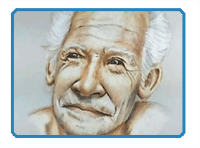
By Matt Fussell
Proportion is the principle of art that is concerned with the relationship of one part of an object or image when compared to another part of an object or image. As you can imagine, when it comes to drawing a human face, proportion is incredibly important. Get the proportions wrong, and you'll end up offending your model. When a realistic portrait is created, the intent is usually to draw the person the way they are seen. The goal is to capture what people refer to as the "likeness" of the person. Some knowledge of the proportions of the human face are obviously required. Conveniently, the main features of the face have relative relationships, so placing them on a face in a drawing doesn't have to be guesswork. The relative placement of the features is outlined briefly in the paragraph below. For more specifics on the placement of facial features check out this page.
When drawing a face, a circle is first drawn to establish the cranium. Next, a line is drawn down to the chin. The lines for jaw are added next. Next, placement of the features is established, starting with the eyes. Eyes are found in the middle of the head, or half-way down from the top of the head. Next, the placement of the nose is established half-way between the eye line and the bottom of the chin. Continuing down the face, the mouth is established next, positioning itself just slightly above half-way between the bottom of the nose and the bottom of the chin. Ears are located between the eye line and the nose line.
Portraits, of course, are created with a variety of media and techniques. Each medium demands its own set of approaches and colored pencils are no exception. The first thing to consider is keeping your medium consistent. Since the portrait is to be drawn with colored pencils, then colored pencils should be the medium that you use throughout completion of the drawing. Many people think that a preliminary drawing absolutely must be done with graphite (pencil). Using a graphite pencil, even in the preliminary stages, will cause issues with your drawing. The graphite, you see, will mix with the wax binder in colored pencils and make your colors appear gray. So, it's best to use only colored pencils. I usually use a light brown for preliminary sketching, like I have in the video tutorial that follows.
Colored pencils perform best when they are layered and mixed. This gives the finished drawing a level of depth and complexity and the drawing almost translates as a painting. It is important to take full advantage of the medium by layering details directly on top of layered applications of colored pencil. Patience also must be exuded, since colored pencils, as a medium, require time. (See which colored pencil brands I recommend here.)
The trickiest part of completing a portrait with colored pencils comes when skin tones are to be mixed. Most all skin tones in the world can be mixed using a combination of red, yellow, brown, and white. Blue is also used for shadows, or to make values darker. But, generally, red, yellow, brown, and white are the colors most used. Some tones will require more brown, while others will require more yellow or white. It is best to create the skin tone that you are after through mixing. This, as mentioned before, will lead to more complexity in the color and will make the drawing appear more realistic.
Here are some more art lessons that you may like...